For quite some time I’ve been meaning to blog about one of my NGO assignments, so I guess that this is just as good an opportunity as any to walk you through my daily activities as an NGO photographer. Perhaps you’re thinking that NGO photography is a dream job and I will attest to the fact that it is in fact a dream job. I meet interesting inspiring people, I find myself seeing unique and compelling situations where storytelling with the camera is not only possible but is all-consuming and mind blowingly phenomenal.
And perhaps you’re thinking that every single image that needs to be made for an NGO has to be something that you might find the cover of Time magazine or on the pages of National Geographic. But in fact, I find myself making some rather mundane images… images that would never make the cover of any magazine, but to the NGO they are important because they tell a piece of their story.
I’m going to share with you about 40 images that I shot today, on my first day here at Hopital Albert Schweitzer. I’ve shot for hospital Albert Schweitzer for almost 10 years now and I usually spend between 3 and 5 days here making images for the hospital that they use in their annual reports, on their website and in other correspondence with their donors and the public.
After spending almost 13 hours in transit to get from San Diego to Port-au-Prince Haiti and then another 3 hours of ground transportation from Port-au-Prince to Deschapelles, I finally arrived, got a bite to eat, and fell into bed. I’m staying here in a guesthouse with several doctors, a physical therapists and some aid workers. There is running water for several hours every day, there is electricity, but no air conditioning, and the beds have mosquito nets which is a good thing, because the place is full of mosquitoes.
I’m here for just a week while those that I’m staying with are here for several months or several years, living in Haiti and helping the hospital provide healthcare to this rural community. It’s not going to be the most comfortable week of my life, but it is certainly going to be one of the most interesting, it always is, here at hospital Albert Schweitzer.
I started my day today photographing doctors nurses and healthcare professionals in the conference room at their morning meeting. There was a slide presentation about a particular disease and the doctors and nurses shared their insights, asked questions, and after about 45 min. left the room to go to treat patients.
One of the first shots that I made was of Ian Rawson, the director of the hospital and Sylvia the medical director. I chose a position where I could photograph Sylvia in the foreground, with Ian behind. Ian is very modest, and he always praises his employees and encourages them. I wanted to impart this feeling in the photograph by using a shallow depth of field to accentuate Sylvia and put Ian in a supporting role slightly out of focus in the background. This is a lesson that I learned years ago while working for a newspaper under the tutelage of a dear friend who passed away recently, Larry Gagnon. Larry always patted me on the back and sent me out on an assignment saying “don’t forget to get a wide shot medium and a tight shot… and on that tight shot try to get as much information as you can rather than just a straight up portrait”. Larry’s words are always in my head when I go on assignment.
The lighting situation in the conference room was rather difficult. After I shot the above photo, the lights were turned off and there was a PowerPoint presentation going on, so from a photographic standpoint it was not necessarily easy. I don’t like to use flash because it makes things look artificial. So, I jacked my ISO up to 3200 on my Nikon D3S and made best images I could using a fair amount of under exposure to keep the pictures true to what I was seeing; which was that it was a very dark room.
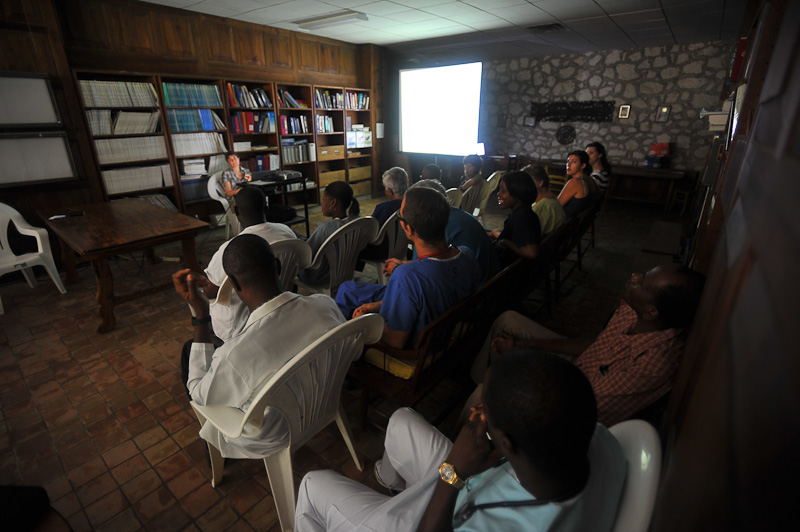
After a wide shot showing the room and the doctors sitting in plastic chairs watching the PowerPoint presentation I chose a position where I could show a number of the doctors and nurses who were learning. I wanted to show that there were Haitians, and whites, as well as both men, and women.
 The next image I made was to show the use of high-tech… a computer and the PowerPoint presentation going on. I felt that it was important that people understand that even in a rural hospital in Haiti computers and PowerPoint presentations now have their place. Ian, the hospital director, later in the day, explained to me that he was having a difficult time getting the Haitian nurses to embrace the computer stations on the wards, where they could input data, rather than write it down on charts the old-fashioned way. Old habits are hard to break, he said.
The next image I made was to show the use of high-tech… a computer and the PowerPoint presentation going on. I felt that it was important that people understand that even in a rural hospital in Haiti computers and PowerPoint presentations now have their place. Ian, the hospital director, later in the day, explained to me that he was having a difficult time getting the Haitian nurses to embrace the computer stations on the wards, where they could input data, rather than write it down on charts the old-fashioned way. Old habits are hard to break, he said.
Having shot an image were my selected depth of field fell upon the woman healthcare professional I then made another shot, almost the same shot, but this time with my focus point on a male. NGOs like hospital Albert Schweitzer often put together a story or piece of literature or a blog post where they need to highlight the fact that either a man or woman Doctor or nurse works at the hospital, so it’s always important to shoot both genders.
Below is an image that’s not very exciting but may come in handy, it’s just another shot of someone giving a PowerPoint presentation but from my newspaper days I knew that it was important to show some action, for example, a gesture. Anything to make a rather boring shot have a little more “life” to it. I remember when shooting for the newspaper, covering press conferences, sitting in the photographer “pool” with about a dozen other photographers. For long periods of time, nothing… and then, as soon as the speaker started to gesture click, click, click, click.
After the meeting and conference center of the hospital finished, I walked to the admitting area where there is always a large waiting line of patients. I kind of like to start where the patients start, it gives me a sense of how the hospital works.
When I’m going to be shooting the particular spot for several days I spend much of my 1st day walking around smiling a lot and making friends, often with my camera at my side. My intention is to scope the place out, see where the interesting stories might be, and make some friends, so that later on, I will be able to create images that are a bit more intimate thanI might be able to create by starting to photograph immediately.
There are some areas of the hospital that have windows that open to the outside and the lighting is fairly bright and even. By starting the shooting this area it’s a little bit easier as I start to get my shutter finger warmed up, and get in the groove.
There was a severely burned boy laying on a cot in the hallway as I approached our eyes met and I smiled, he smiled back, I knelt down beside him and although I don’t speak Creole or French I had a bit of a conversation with him. I took a random snapshot down the hallway and showed him the back of my camera, he smiled. I then motioned to him like… can I take your picture? He smiled back and so I took his picture and showed him. He was very pleased, so I took another and then another. I know there’s an interesting story behind this boy so I made a mental note to myself that I needed to come back here, makes more pictures and get the story. But for now, I just wanted to break the ice, So I smiled and said in English I’ll be back. I’m not sure he understood what I said but at least he knew I was trying to communicate with him, And that I was his new friend.
Next, I went to the neonatal unit and started to photograph some of the nurses taking care of the premature babies. Since the room is very small and sometimes it’s not possible to get into the position that one might need to make the best image possible, I held my camera at arms length up against the wall behind the bed with 2 babies are and shot back towards the 2 nurses. I’ve been shooting my 17-35 f2.8 for so long, I can pretty much tell exactly what the frame is to look like without ever looking through the viewfinder. thank goodness for autofocus, I selected a fairly deep depth of field and moved the focusing sensor slightly right of center hoping to catch one of the nurses to keep in focus.
While walking through the malnutrition ward I looked down hallway towards where the bathroom was, there was light streaming in from an open window to my right and the mother sitting with 4 children. The lighting was quite nice so I made several images with my long lens and then moved entire with my wide.
I recalled seeing an image by James Nachtwey, involving the TB patient and an x-ray, one where Nachtwey shot through the x-ray. I’m a big fan of James Nachtwey, as I’m sure many of you are. I take no credit for this being an original idea, I think it makes a fairly compelling image. Of course, we can’t all be as good as James, and you can see that my focus was not tack sharp on the x-ray, something I didn’t notice until I got back to the computer. So, tomorrow I’ll be going back to repeat the same image, to try to get it right.
In Haiti as in many developing countries, the hospitals do not provide food for the patient’s, but rather parents, brothers, sisters, or other family members stay at the hospital and cook for those who are bedridden. since this is not a common practice in the United States and make it a point to go over to the kitchen area to photograph some of the mothers preparing food for their children were sick.
In the kitchen area, along with some of the mothers, are other siblings who are not sick. They are usually hanging around playing or just exploring and when a photographer like me comes by, an anomaly here at the hospital, they are always interested in what I am doing. So in this case I took the opportunity to make some photographs of the children… the lighting was quite nice.
I always try to include what I call “eye candy” in my portraiture…. a little something extra to make the shot a bit more interesting. In the shot below I photographed the little girl using a shallow depth of field and included a 2nd child in the background for additional visual interest.
Okay, folks, I’ve got more than 30 images to show you but it’s already after midnight and I’m getting eaten alive by mosquitoes as I sit here in the dark trying to post to my blog, so you will have to wait till tomorrow and I’ll do my best to finish up I’ve started writing today… that is…. to walk you through a typical day shooting at hospital Albert Schweitzer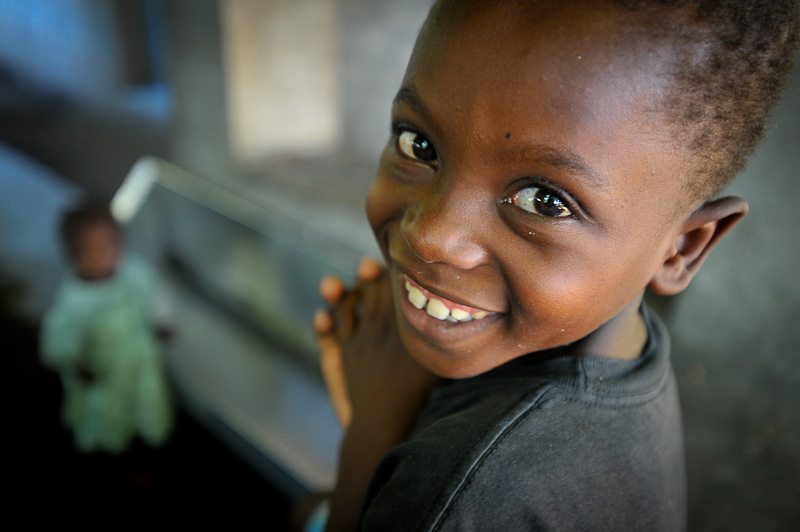
OK, good morning everyone. Didn’t sleep much last night…too hot and the mosquitoes were out in full force. It’s amazing how the find any possible way to find you….like if, during the night any part of your body touches the mosquito net, they bite through the net. It reminds me of a saying, which applies to development work and donors. “If you think the efforts of one individual will be nothing, then you have never been to bed with a mosquito”. —Betty Reese
Anyway, I’m having some much needed coffee and I’ll try and post a few more pictures before I head out to shoot agro-forestry today.
I’m posting a shot below to make a point….I don’t shoot too many images like the one below, because the days of “shock the audience” with something so sad, depressing or shocking that they will donate money, are gone. All my NGO clients want uplifting, positive images. So I will be back to shoot more of this girl, as I want to create a more positive shot to go along with this one.
There are two patients in the room where the image above was shot. So I turn 180 degrees and made a photo of the child in the other bed. It was a bit more challenging due to the back-lighting conditions, so I used a bit of positive exposure compensation to make the shot.
Next I made my way to the Orthotics lab to photograph elements of Hopital Albert Schweitzer’s program to treat amputees. In the immediate aftermath of the earthquake, the hospital saw and treated a huge number of amputees.
When I arrived in Port-au-Prince at the airport I met Shiuan Huang, a Dr. of Physical Therapy, from Colorado. We ended up spending some time together in the car on the way to the hospital, almost 3 hours. So I discussed the volunteer activities that she would be undertaking during her stay at the hospital. This background information is key to being able to shoot the images that go along with the story. I have a background in orthopaedic medical sales from a prior life, when I sold hip and knee implants for Johnson & Johnson orthopedics, so I was able to communicate quite well with Dr. Shiuan. I was anxious to get to the prosthetics lab to photograph her activities.
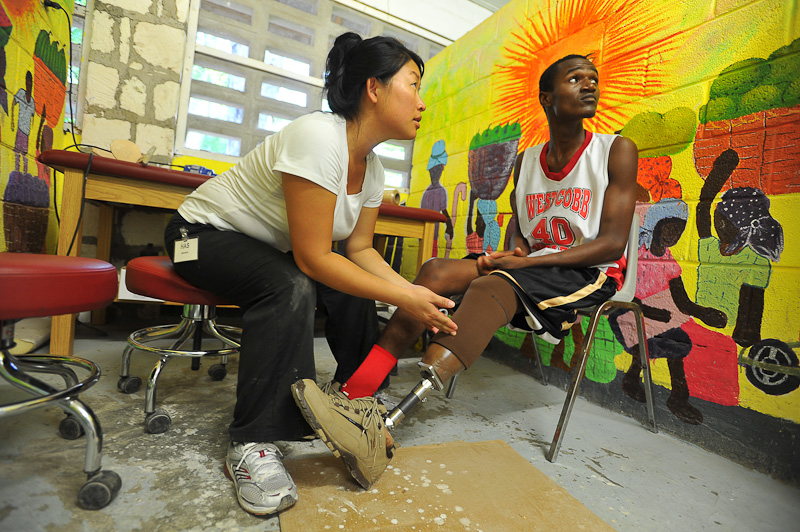 Hospital Albert Schweitzer requested plenty of images of patient interacting with healthcare professionals so I made a series of images of the physical therapist working with the patient, including pictures of the prosthetic limb as well as the patient’s stump. There are a lot of technical details that physical therapists and health care professionals will understand about this particular image and the image of the patient’s stump.
Hospital Albert Schweitzer requested plenty of images of patient interacting with healthcare professionals so I made a series of images of the physical therapist working with the patient, including pictures of the prosthetic limb as well as the patient’s stump. There are a lot of technical details that physical therapists and health care professionals will understand about this particular image and the image of the patient’s stump.
Shiuan, was explaining to the patient that proper posture was key to normal walking gait. using a translator she spoke to the patient and demonstrated using her hands. In a very short period of time it was evident that the patient had understood the instructions.
My visit to the Orthotics lab was very brief…more Just like a reconnaissance run, a way to familiarize myself with the facility so that when I go back tomorrow I will have a better understanding of the lighting situation and the dynamics of shooting in this environment.
As I was leaving the orthotics lab I turned around to see a mother and daughter sitting on a bench near the entrance. I made several frames, this is the one I like the best.
 Physicians can relate to things like NPO ( nothing by mouth) … this child was outside the surgery suite waiting to be wheeled in for surgery. A small piece of tape with the letters NPO printed on it assures that no one gives him something to eat or drink.
Physicians can relate to things like NPO ( nothing by mouth) … this child was outside the surgery suite waiting to be wheeled in for surgery. A small piece of tape with the letters NPO printed on it assures that no one gives him something to eat or drink.
Hospital beds here in Haiti are older style beds that that have little bars that often need painting I chose a low angle to shoot a child through the bars so the viewer get an idea of the facilities and how they are not exactly like you would find in the United States.
Late in the afternoon I made a final loop through the hospital to photograph my favorite subject, the boy that you saw on the lead image for this post. He has the most engaging eyes and his smile is worth $1 million or at least let’s hope his smile was worth $1 million for hospital Albert Schweitzer.
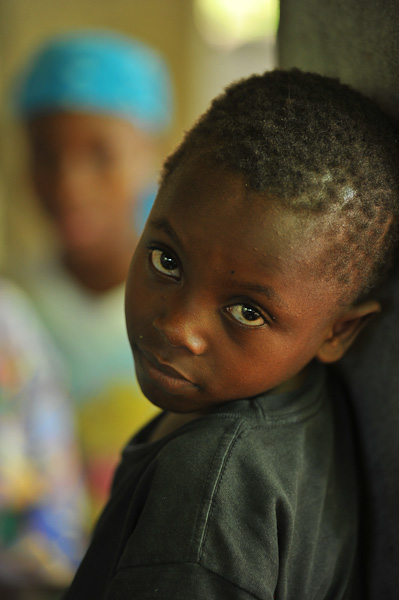 I still have approximately 20 images to show you from my 1st days shooting, I will try to up load those this evening because I really want to show you what a full day of shooting looks like. So, please stay tuned and come back to this post to see additional images.
I still have approximately 20 images to show you from my 1st days shooting, I will try to up load those this evening because I really want to show you what a full day of shooting looks like. So, please stay tuned and come back to this post to see additional images.
There is a follow up outbreak happening here in Haiti and UNICEF donated some parents, they were set up on the campus of hospital Albert Schweitzer, so I stopped by the Cholera tents to make some photographs of patients.
Then, I went into one of the buildings adjacent to the tents to interview and photograph one of the nurses who is key to Cholera treatment. I tried to make an environmental portrait of her showing her doing some work attending to patients.
There is a special area for children with cholera so I made some photographs in the “pediatric cholera ward”.
Cholera is all about vomiting and diarrhea which cause dehydration, every patient with cholera has numerous IV bags to rehydrate them until they are at the point where they can drink rehydration liquid. I want to make an image that showed an IV dripping fluid, so I used my 17-35 lens and got very close to the dripping solution and let the patient on the bed fall significantly out of focus; thereby drawing attention to the IV rather than to the patient.
After visiting the cholera ward, I took a little walk around the village to make some photographs of things that were obviously Haitian like the brightly colored home that you see below. Interestingly enough, this home has the same color palate as the Hopital Albert Schweitzer website!
the family in the 2 photographs above and sustained significant damage from a flood in the area, so they were keen to show me around and explain what had happened to them. So many people just want someone to listen.
One of the reasons for the cholera outbreak in Haiti was contaminated water. this stream flows just behind the hospital and people cross it to get from one side of the village to the other. I made several images of people crossing the river which included a girl getting water. I am not sure that she was planning on drinking the water however the image suggests that she might be.
I noticed that the young boy that I was photographing in the prosthetics lab, was on his way home. His prosthetic leg remained in the shop for adjustment so he was on crutches as he made his way home. I chatted with him for a few minutes and as he walked away I used my 70-200 mm lens to make a photograph, compressing the path that he was walking on, with another person in the distance for a little bit of extra visual interest in the frame.
On my way back to the house where I am staying, I went over to the cholera award which I had noticed the evening before; was interestingly lit. The UNICEF tents had a “glow” about them, with the lights on the inside. They looked beautifully radiant, against the cobalt blue of the evening sky.
well, I guess that just about wraps it up…. there’s a typical days shooting for an NGO.



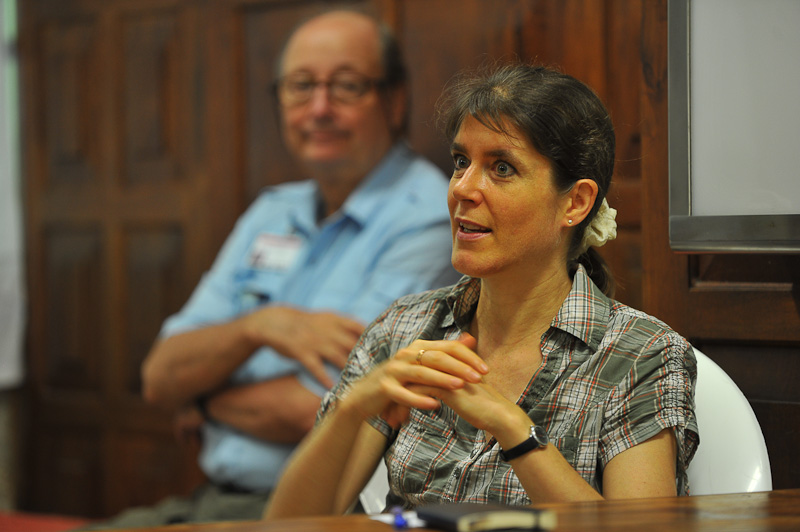
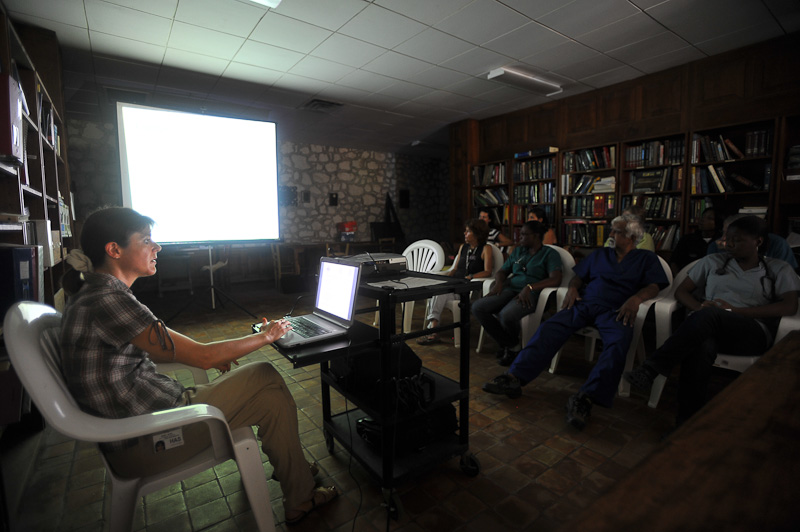


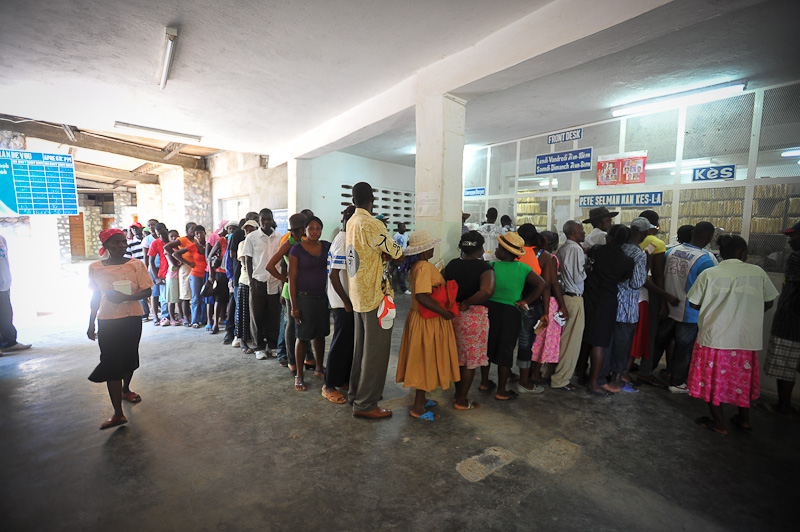

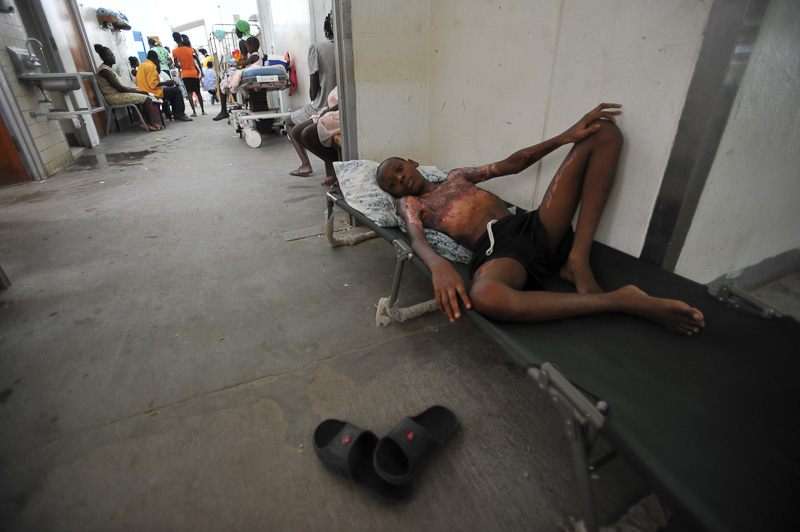
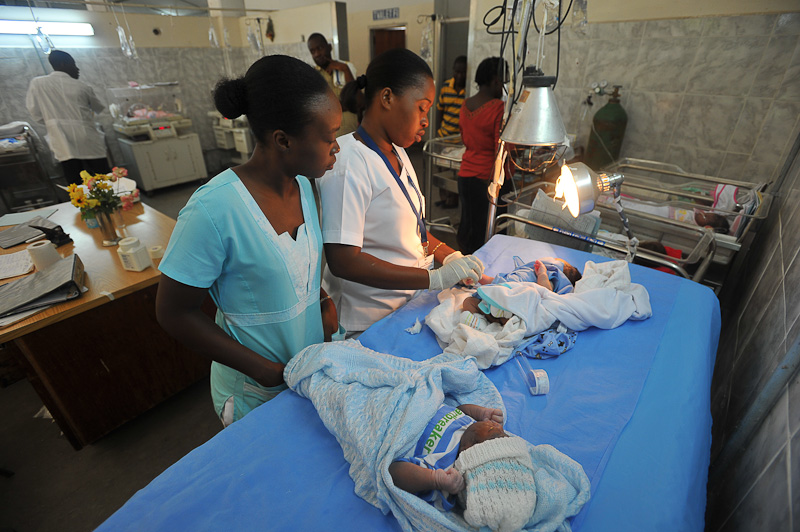

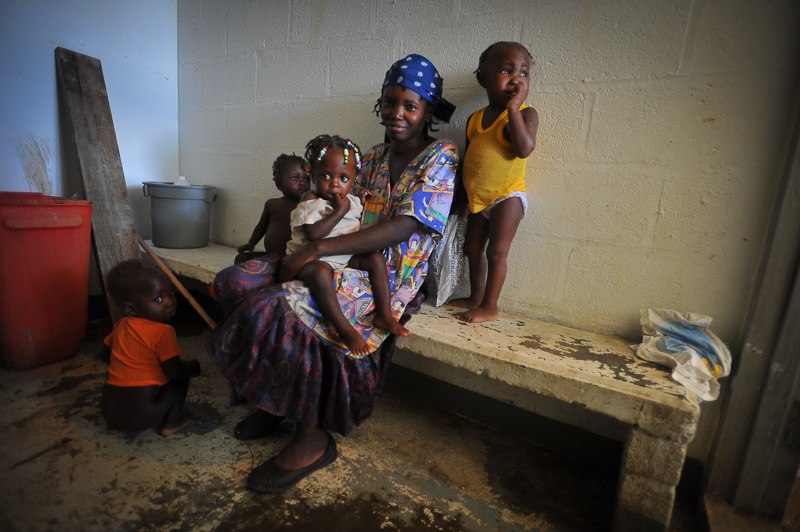


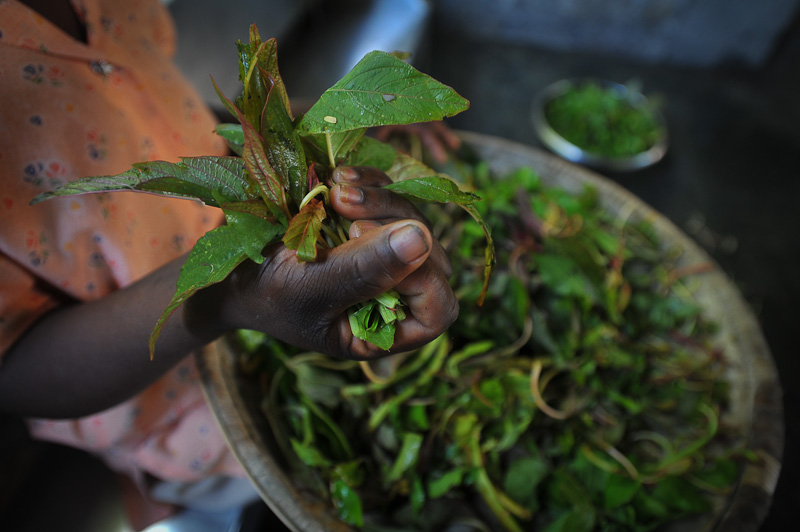



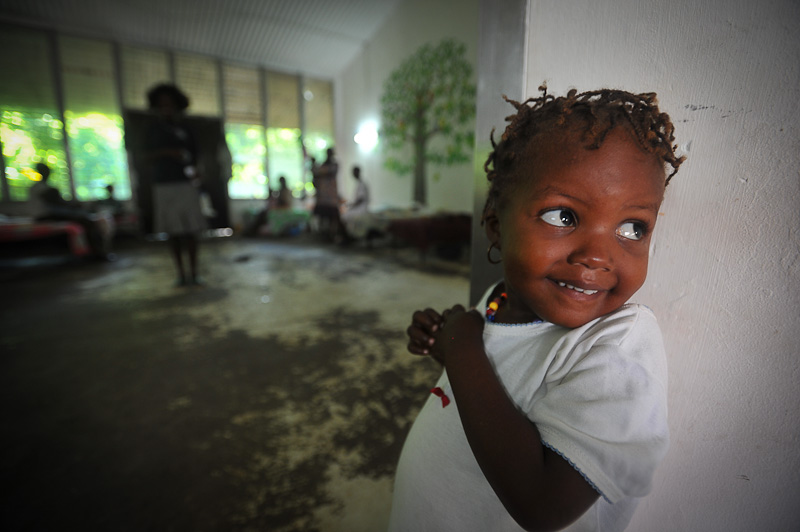
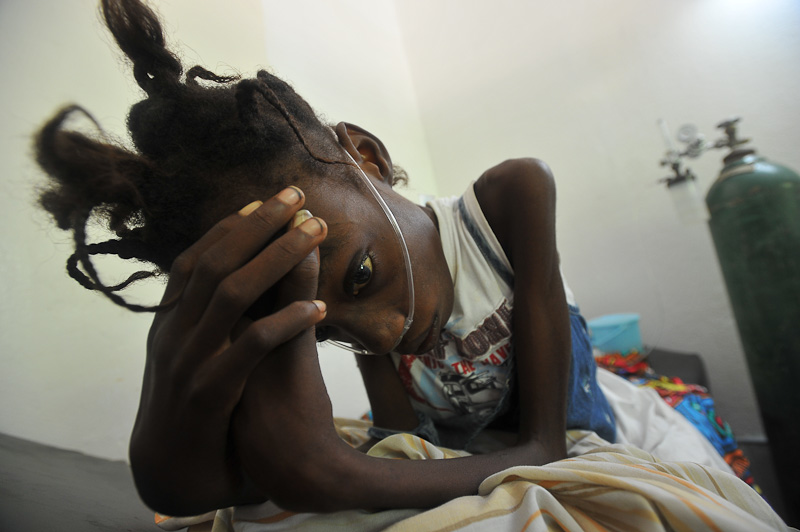

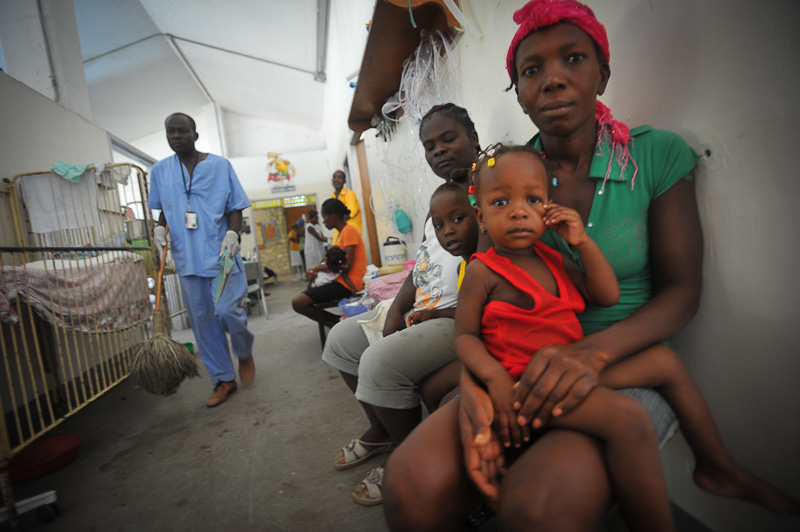

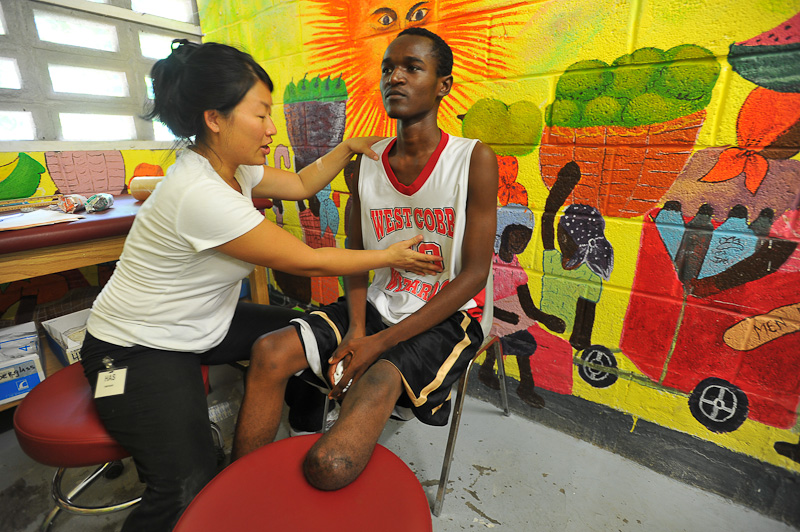
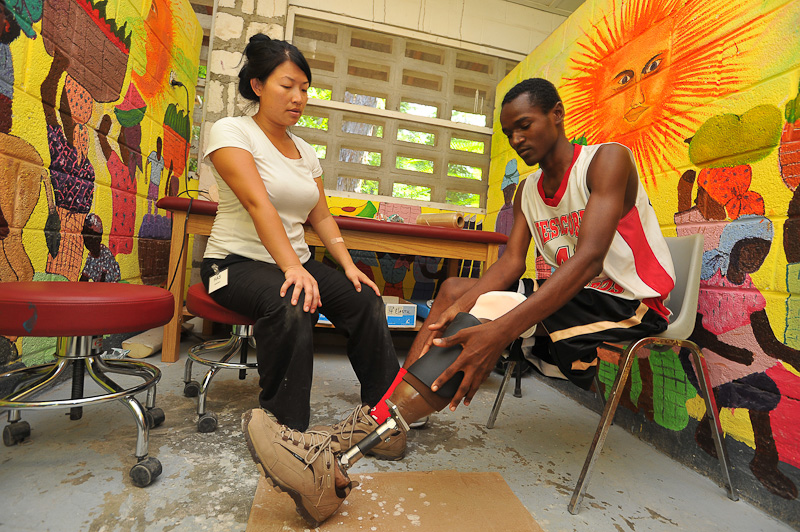

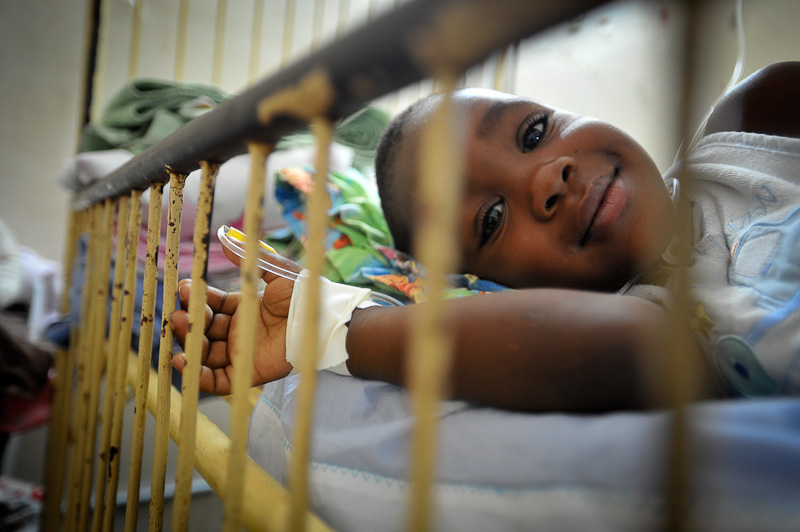

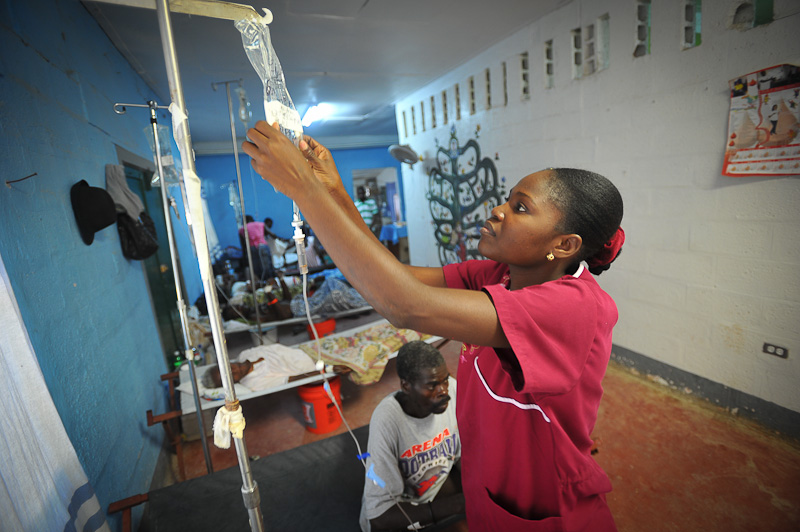
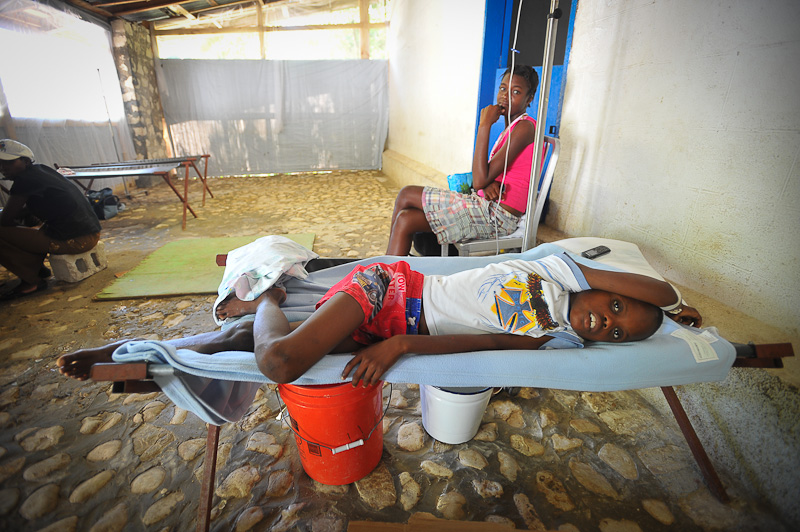
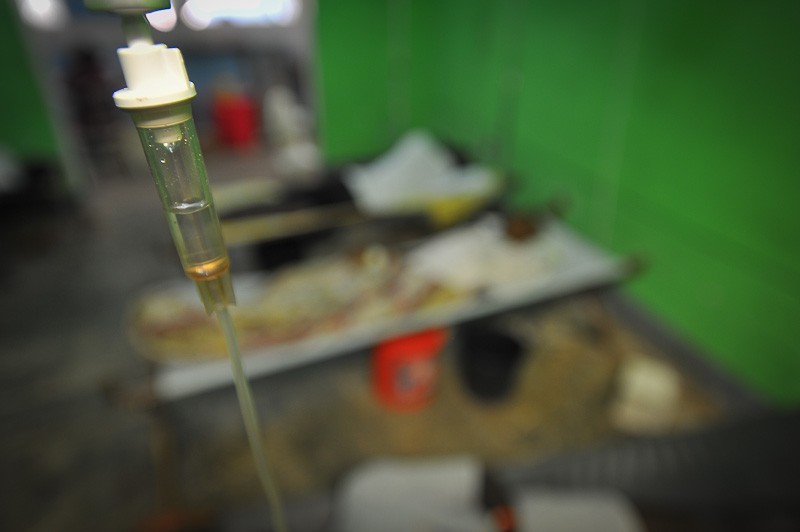
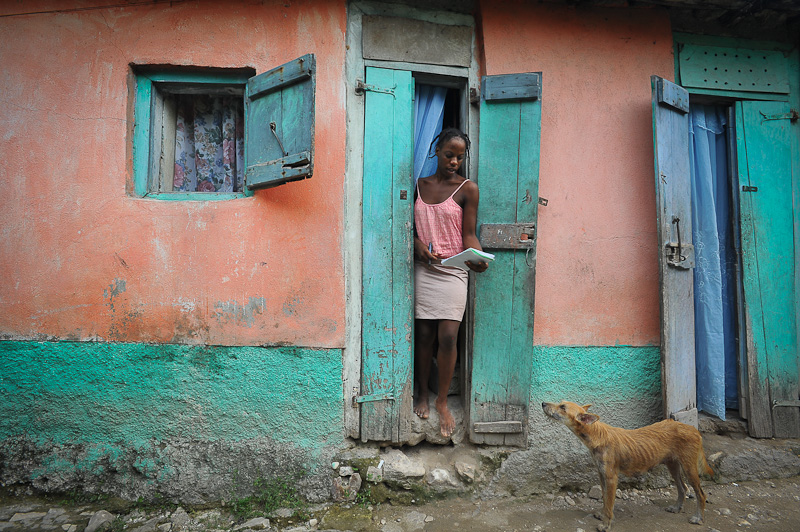
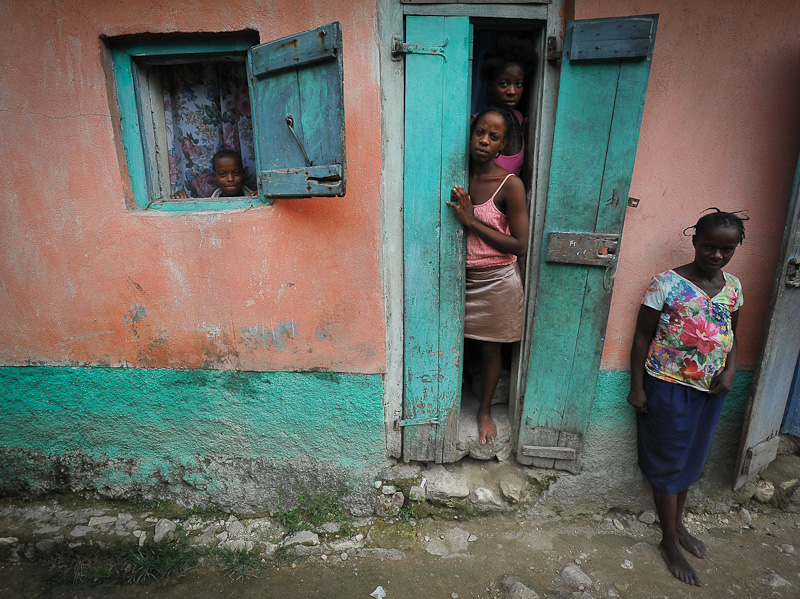
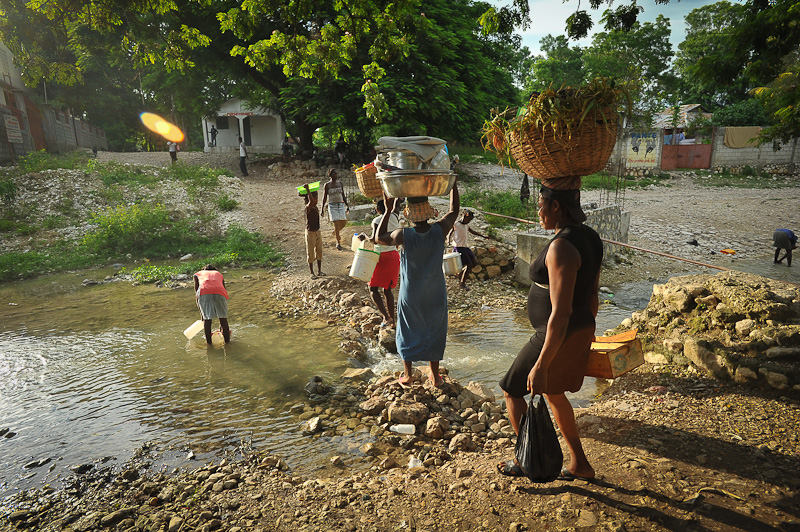
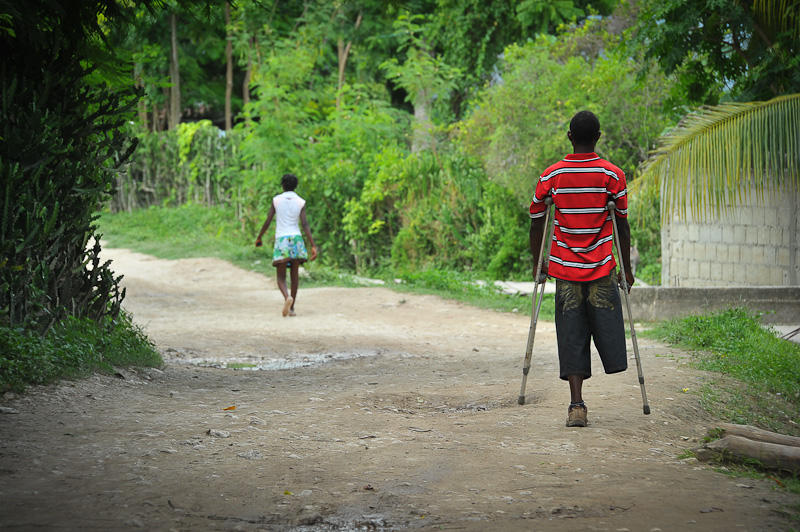
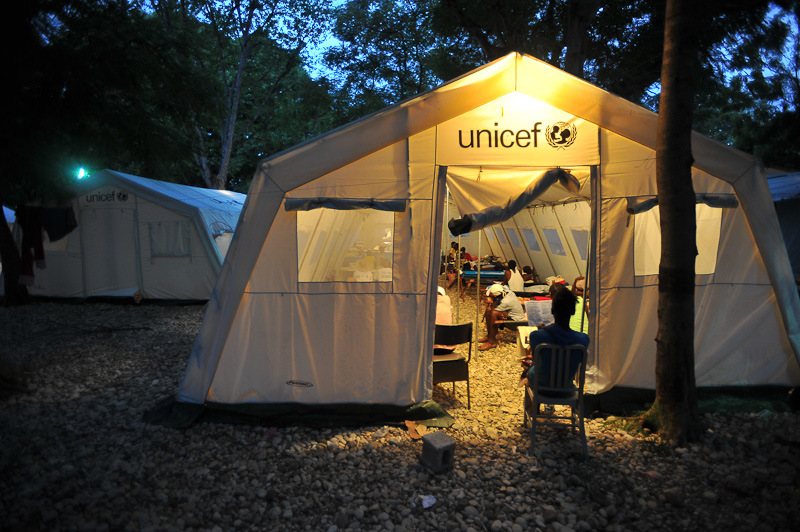







Hi Karl! Seeing these images and reading your blog make be feel like I am back in Haiti on a photoshoot with you. You bring it to life so elegantly. Thank you for sharing both the images and your thoughts. Look forward to seeing more!!!
Warm regards,
Rona
Beautiful post Karl, love the way you explained your daily life and the photographs are not mundane; they usually shows what, we human don’t want to see. We need images like this, watching them brings me back to basics and usually brought a tear to my eye. I never thought you have a dream job but, as the local workers and volunteers, your are doing an admirable work. Keep up with the good work ! Nath
Karl, thanks for this post..it brings together so much of what you teach. I really enjoyed looking through the photographs and seeing all the different ways to shoot a scene to tell a story more effectively..they make you want to get on a plane and go help..looking forward to our next adventure..Catherine
WOW!
Thanks, Karl. And this from the man who, so generously told me that if I had ONE good shot from a day, it was a good day!
When can I come follow your shoes?
Thanks very much for sharing remarkable moving images as well as showing your unique way to make them.
Fantastic my friend!!!
This is what I am talking about, this material can be on any magazine, newspaper, and website. It is a great way to promote a NGO as well as teaching people that love photography about the craft. Man you have no idea how much I enjoyed this ( I guess you know) but man, I am here smiling from ear to ear and happy to learn a bit more from you.
I just want to thank you very very much!
Cheers
Celso Mollo
Thanks Celso, I really appreciate your kind words!
Hi Kim, Thank you so much for you nice comment!
Hi Ursula. Thanks for the comment…but of course, you have plenty of great images in a day’s shooting too! I’ve seen your work and your blog!
Thanks Catherine, you comment makes the effort worth while…I am glad you enjoyed it
Thanks Nath, I really appreciate you taking the time to tell me about your feelings after reading the post. I am always in awe of the aid workers and volunteers…I’m just a photogapher.
Hi Rona,
Yes, I remember our time, working together in Haiti! I wish you were here working with me again…we are off to Tien dispensary tomorrow and I will be thinking of you. Let’s touch base when I get back. Cheers, Karl
Karl:
It was a pleasure meeting you at HAS. Your professionalism and competence is extraordinary. Your touch in getting accessories for those 2 patients was heartwarming.
Godspeed, my friend.
AC
Thanks Alain, I really appreciate the nice compliment. Frankly, I consider it a huge privilege to photograph you guys doing your important work. I think it’s awesome that you volunteer your time and expertise to help those less fortunate than yourself. Keep up the great work! Oh, and if you get a chance drop over and see how Rose is doing. I can’t get her off of my mind. Cheers, Karl
Hi Karl,
I have been following your work for some time now and I have to say that I am very impressed with it. But my question is rather technical – you said you don’t like to use flash and I agree that in dark room it would add artificial effect. Do you use fill flash though to bring in the faces/shadows? Or you rather adjust exposure possibly? I find Nikons to be very good with fill flash and some negative compensation set for it. You take some great portraits, even those with wide angle lens are impressive! Thanks.
.
Artur, thanks for following the blog, and for your nice compliment. Regarding flash, I use it only when absolutely necessary. Either outdoors in full sun, to fill in the shadows, and indoors when there is a low enough ceiling that I can bounce off of it. You are correct, Nikon’s do a great job with fill flash, as long as you use flash compensation to about 1/2 to a full stop, under the ambient light reading. Good question! Cheers, Karl
Karl, it was wonderful having you back with us again in Deschapelles; your images are truly beautiful, and they never fail to capture the person and the context, as well as the purpose. We have appreciated your support of HAS through your sensitive images, which are to a great extent now, the face of HAS. Best wishes, Ian
Dear Mr Karl Gobl
thanks for the pictures from the HAS which I enjoyed looking at. I had an opportunity to visit the HAS in Deschapelles in the sommer of 2010 during a medical humanitarian engagement in Port-au-Prince after the earthquake. I was not only impressed by the work of the medical and nursing staff but also by the activities of the prosthetics lab and the dedicated work of the mothers in the kitchen. Your pics refreshed my memories of that visit and the warm reception at the HAS. Best Regards.
These beautiful pictures almost made me shed a tear. Both because of the feelings you have put in them and the compositional brilliance. I wish some day i will become a great photographer like you. The life you have is something to dream about.